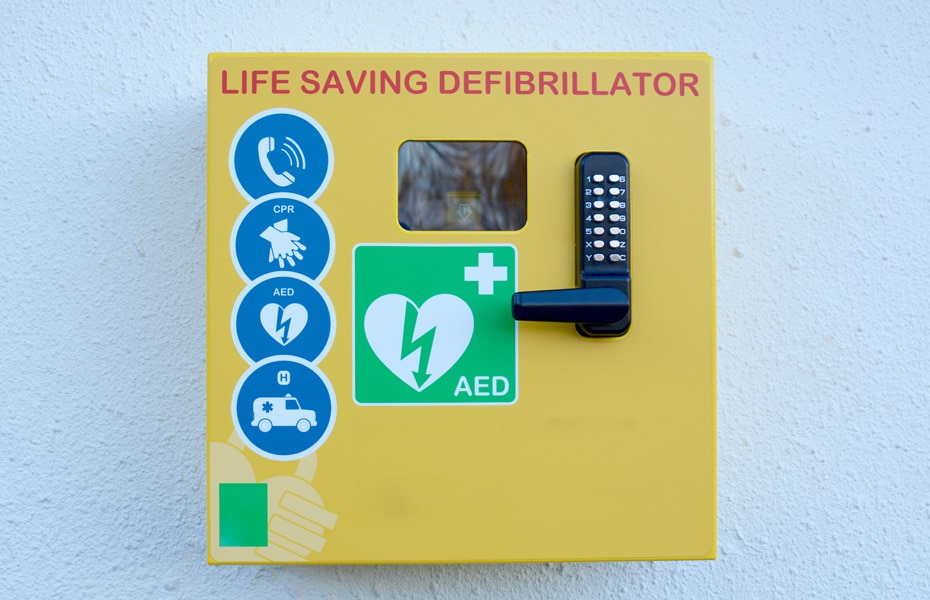Enter your email address to receive the latest ITVET news, market insights, and useful IT tips.
At ITVET, we have invested in a defibrillator for our local community. This will be attached to the outside wall of our Bishop’s Stortford office. Our company was founded with the intention to provide consistent customer satisfaction and to bring a positive impact to our local community. We do this in many ways, from our laptops for schools campaign, our charity work, our client communications, and now with our defibrillator investment. This defibrillator contributes to our objective to provide a positive impact on our wider community.
What is a defibrillator?
A defibrillator is a life-saving device when a person enters cardiac arrest. Before the arrival of an ambulance, a defibrillator is used to monitor the heart’s rhythm, issuing shocks if needed. The sooner you attach the defibrillator the higher the survival rate.
Cardiac arrest
Cardiac arrests can happen to anyone, at any time. Unfortunately, cardiac arrests happen without warning. Preparation is vital for survival. There are over 30,000 cardiac arrests a year in the UK that take place out of hospital.
A cardiac arrest is when your heart suddenly stops pumping blood. It’s triggered by an electrical malfunction in the heart that causes an irregular heartbeat. Oxygen can’t be transported to the vital organs including the lungs and brain which causes a person to fall unconscious and stop breathing. Immediate treatment is needed in this scenario.
In the first instance, 999 must be called immediately. Whilst one person performs CPR another should fetch the defibrillator and carefully follows its instructions. The operator on the emergency call will talk you through what to do.

How a defibrillator helps
The defibrillator assesses the heart rhythm and tells you when to shock the person if they require it. The purpose of a shock is to reset the electrical system in the heart to help it beat normally again. The shock is a brief electrical current that is sent through the heart. This allows the body’s natural pacemaker to re-establish its rhythm.
In the UK, less than 2% of cardiac arrest victims have a defibrillator deployed before the ambulance arrives. More defibrillators are desperately required in public places and workspaces to help more people survive.
Laura McNab, a registered nurse, and the Clinical Educator for Resuscitation Training informs us “providing defibrillation within the first 3-5 minutes of a collapse can produce survival rates of 50-70%. For each minute a person is without access to a defibrillator, chances of survival are greatly reduced.”
It is because of this extremely short time frame that defibrillators need to be sited on a very localised basis. Having to travel far reduces the patient’s chance of survival. Any area with a significant population density will benefit from having a defibrillator. This is why they are sited at schools, libraries, public buildings and health care centres around the UK.
The defibrillator at ITVET’s head office ensures that if any of our staff or a local member of the community experience a cardiac arrest, they can get help quickly. We want to increase their chance of survival by getting it to them as soon as possible.
Who can use a defibrillator?
What makes a defibrillator so useful is that it doesn’t need any official training to use. There are clear instructions on how to attach the defibrillator pads. The device tells you through visual and vocal prompts when to deliver a shock if it is needed. This guidance ensures you can’t do any harm to the person in cardiac arrest.
When should you use a defibrillator?

These are the main signs of a cardiac arrest that must be acted on immediately. At this point, their heart is no longer pumping blood to their brain and they are in a critical condition.
A stark reminder of how important defibrillators are
The world recently watched on in horror as Danish Striker Christian Eriksen collapsed in the middle of a football match with a cardiac arrest. In his Doctor’s words “He was gone.” Having near immediate access to a defibrillator and full medical team undoubtedly saved his life. Since this event, campaigners have renewed their calls for more access to defibrillators.
The defibrillator is now situated on the outside wall of our central office in Bishop’s Stortford. This investment is part of our corporate responsibility to the wider community of Bishop’s Stortford.


